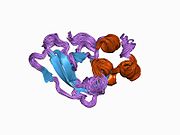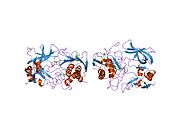TIMP1
Ensembl | |||||||||
|---|---|---|---|---|---|---|---|---|---|
| UniProt | |||||||||
| RefSeq (mRNA) | |||||||||
| RefSeq (protein) | |||||||||
| Location (UCSC) | Chr X: 47.58 – 47.59 Mb | Chr X: 20.74 – 20.74 Mb | |||||||
| PubMed search | [3] | [4] | |||||||
| View/Edit Human | View/Edit Mouse |
TIMP metallopeptidase inhibitor 1, also known as TIMP1, a
This protein is a member of the
Function
TIMP1 is an inhibitory molecule that regulates matrix metalloproteinases (MMPs), and disintegrin-metalloproteinases (ADAMs and ADAMTSs).[6] In regulating MMPs, TIMP1 plays a crucial role in extracellular matrix (ECM) composition, wound healing,[7] and pregnancy.[8][9][10]
The dysregulated activity of TIMP1 has been implicated in cancer.[11] In pregnancy, TIMP1 plays a regulatory role in the process of implantation, particularly the cytotrophoblast invasion of the uterine endometrium.[12] Additionally, it plays a role in regulating the transcriptional profile of fetal and placental tissues associated with the early stages of pregnancy.[13] Studies attribute this role to a mechanism involving the chromatin structure at the TIMP1 promoter region, implicating new pharmaceutical possibilities for the therapeutic regulation of TIMP1. Accordingly, TIMP1 can be manipulated in vitro using techniques, like the TIMP1 knock-out.[14][15][16]
Other names
- Erythroid potentiating activity (EPA)
- Human collagenase inhibitor (HCI)
Regulation of TIMP expression
In adrenocortical cells the trophic hormone ACTH induces expression of TIMP-1 and the increase in TIMP expression is also associated with decreased collagenase activity.[18]
Increased expression of TIMP1 has been found to be associated with worse prognosis of various tumors, such as
See also
References
- ^ a b c GRCh38: Ensembl release 89: ENSG00000102265 – Ensembl, May 2017
- ^ a b c GRCm38: Ensembl release 89: ENSMUSG00000001131 – Ensembl, May 2017
- ^ "Human PubMed Reference:". National Center for Biotechnology Information, U.S. National Library of Medicine.
- ^ "Mouse PubMed Reference:". National Center for Biotechnology Information, U.S. National Library of Medicine.
- PMID 15458430.
- PMID 20080133.
- PMID 10708863.
- S2CID 3145982.
- PMID 9160717.
- PMID 10952938.
- PMID 23187000.
- S2CID 3145982.
- PMID 26691525.
- PMID 24143225.
- S2CID 18499513.
- S2CID 3145982.
- ^ "Entrez Gene: TIMP1 TIMP metallopeptidase inhibitor 1".
- S2CID 6836003.
- PMID 24427345.
- PMID 24457057.
Further reading
- Hornebeck W (December 2003). "Down-regulation of tissue inhibitor of matrix metalloprotease-1 (TIMP-1) in aged human skin contributes to matrix degradation and impaired cell growth and survival". Pathologie-Biologie. 51 (10): 569–73. PMID 14622947.
- Gardner J, Ghorpade A (December 2003). "Tissue inhibitor of metalloproteinase (TIMP)-1: the TIMPed balance of matrix metalloproteinases in the central nervous system". Journal of Neuroscience Research. 74 (6): 801–6. PMID 14648584.
External links
- The MEROPS online database for peptidases and their inhibitors: I35.001
- Overview of all the structural information available in the PDB for UniProt: P01033 (Metalloproteinase inhibitor 1) at the PDBe-KB.




